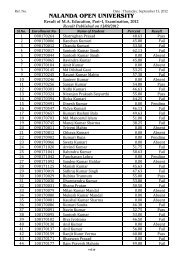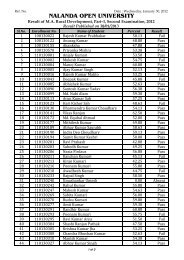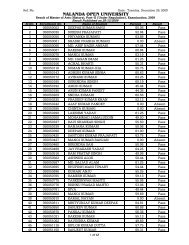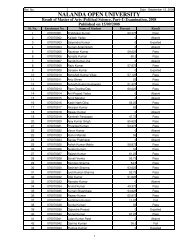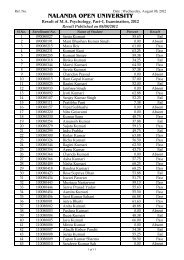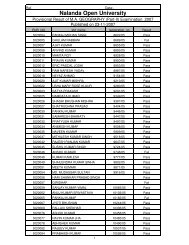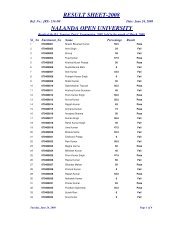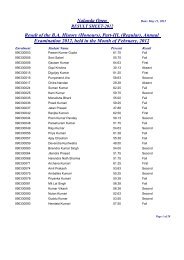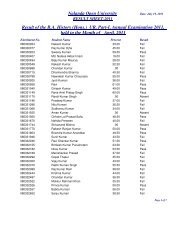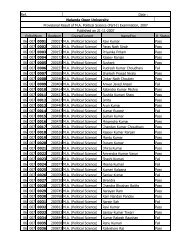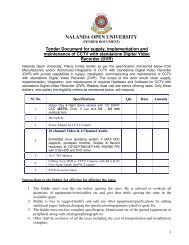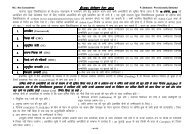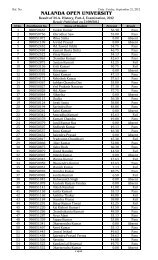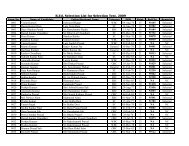M.A. (Education) Part I and II - Nalanda Open University
M.A. (Education) Part I and II - Nalanda Open University
M.A. (Education) Part I and II - Nalanda Open University
Create successful ePaper yourself
Turn your PDF publications into a flip-book with our unique Google optimized e-Paper software.
NALANDA OPEN UNIVERSITY<br />
M.A. [<strong>Education</strong>]<br />
PART–I, PAPER–I<br />
¼Principles of <strong>Education</strong>½<br />
Annual Examination, 2012<br />
Time : 3 Hours Full Marks : 80<br />
fdUgha fdUgha fdUgha fdUgha ik¡p ik¡p ik¡p ik¡p iz'uksa iz'uksa iz'uksa iz'uksa ds ds ds ds mÙkj mÙkj mÙkj mÙkj nhft, nhft, nhft, nhft, A A A A lHkh lHkh lHkh lHkh iz'uksa iz'uksa iz'uksa iz'uksa ds ds ds ds vad vad vad vad leku leku leku leku gSa gSa gSa gSa A AA<br />
A<br />
Answer any Five Questions. All questions carry equal marks.<br />
1. Define <strong>Education</strong> <strong>and</strong> discuss aims of education.<br />
f'k{kk dks ifjHkkf"kr dhft, rFkk f'k{kk ds mís';ksa dh foospuk dhft, A<br />
2. Write an essay on different bases of education.<br />
f'k{kk ds fofHkUu vk/kkjksa ij ,d fucU/k fyf[k, A<br />
3. Describe the role of family in education <strong>and</strong> explain its relationship with school as an<br />
agency of education.<br />
f'k{kk esa ifjokj dh Hkwfedk dh foospuk dhft, rFkk f'k{kk ds ,d vfHkdj.k ds :i esa Ldwy ds<br />
lkFk blds lEcU/kksa dh O;k[;k dhft, A<br />
4. What do you mean by curriculum? What are the main principles of curriculum<br />
construction?<br />
ikB~;Øe ls vki D;k le>rs gSa \ ikB~;Øe fuekZ.k ds eq[; fl)kUr D;k gSa \<br />
5. Examine the features of the New <strong>Education</strong> Policy of 1986.<br />
1986 dh u;h f'k{kk uhfr dh fo'ks"krkvksa dk ijh{k.k dhft, A<br />
6. What do you mean by National Integration? Discuss its various dimensions <strong>and</strong><br />
importance.<br />
jk"Vªh; ,drk ls vki D;k le>rs gSa \ blds fofHkUu vk;keksa ,oa egÙo dk foospu dhft, A<br />
7. Throw light on recommendations given by different Commissions regarding progress<br />
of women education in India.<br />
Hkkjr esa L=h&f'k{kk dh izxfr esa fofHkUu vk;ksxksa }kjk nh x;h flQkfj'kksa ij izdk'k Mkfy, A<br />
8. Examine the role <strong>and</strong> functions of <strong>University</strong> Grant Commission in development of<br />
Higher <strong>Education</strong>.<br />
mPp f'k{kk ds fodkl esa fo'ofo|ky; vuqnku vk;ksx dh Hkwfedk ,oa dk;ksZa dk ijh{k.k dhft, A<br />
9. Discuss the recommendations of Mudalear Commission regarding Secondary <strong>Education</strong>.<br />
ek/;fed f'k{kk ds fy, eqnkfy;j vk;ksx }kjk fn;s x;s flQkfj'kksa dk o.kZu dhft, A<br />
10. Discuss the merits <strong>and</strong> demerits of the essay-type examination pattern.<br />
fucU/kkRed&ijh{kk Lo:i ds xq.kksa ,oa nks"kksa dk foospu dhft, A<br />
<br />
Examination Programme-2012<br />
M.A <strong>Education</strong> (<strong>Part</strong>–I)<br />
Date Papers Time Examination Centre<br />
09.05.2012 Paper–I 12.00 Noon to 3.00 PM Nal<strong>and</strong>a <strong>Open</strong> <strong>University</strong>, Patna<br />
11.05.2012 Paper–<strong>II</strong> 12.00 Noon to 3.00 PM Nal<strong>and</strong>a <strong>Open</strong> <strong>University</strong>, Patna<br />
15.05.2012 Paper–<strong>II</strong>I 12.00 Noon to 3.00 PM Nal<strong>and</strong>a <strong>Open</strong> <strong>University</strong>, Patna<br />
17.05.2012 Paper–IV 12.00 Noon to 3.00 PM Nal<strong>and</strong>a <strong>Open</strong> <strong>University</strong>, Patna<br />
19.05.2012 Paper–V 12.00 Noon to 3.00 PM Nal<strong>and</strong>a <strong>Open</strong> <strong>University</strong>, Patna<br />
21.05.2012 Paper–VI 12.00 Noon to 3.00 PM Nal<strong>and</strong>a <strong>Open</strong> <strong>University</strong>, Patna<br />
23.05.2012 Paper–V<strong>II</strong> 12.00 Noon to 3.00 PM Nal<strong>and</strong>a <strong>Open</strong> <strong>University</strong>, Patna<br />
25.05.2012 Paper–V<strong>II</strong>I 12.00 Noon to 3.00 PM Nal<strong>and</strong>a <strong>Open</strong> <strong>University</strong>, Patna
NALANDA OPEN UNIVERSITY<br />
M.A. [<strong>Education</strong>]<br />
PART–I, PAPER–<strong>II</strong><br />
¼Development of <strong>Education</strong> in India½<br />
Annual Examination, 2012<br />
Time : 3 Hours Full Marks : 80<br />
fdUgha fdUgha fdUgha fdUgha ik¡p ik¡p ik¡p ik¡p iz'uksa iz'uksa iz'uksa iz'uksa ds ds ds ds mÙkj mÙkj mÙkj mÙkj nhft, nhft, nhft, nhft, A A A A lHkh lHkh lHkh lHkh iz'uksa iz'uksa iz'uksa iz'uksa ds ds ds ds vad vad vad vad leku leku leku leku gSa gSa gSa gSa A AA<br />
A<br />
Answer any Five Questions. All questions carry equal marks.<br />
1. Trace the history of Ancient Indian education system from down of civilization to<br />
sometime around fourteenth century A.D.<br />
lH;rk ds izkjEHk ls ysdj yxHkx 14oha 'krkCnh rd dh Hkkjrh; izkphu f'k{kk i)fr ds<br />
bfrgkl dks js[kkafdr dhft, A<br />
2. Discuss the contents of Woods Despatch 1854. Examine its importance.<br />
oqM~l fMLiSp 1854 ds vUrcZLrq dk foospu dhft, A blds egÙo dk ijh{k.k dhft, A<br />
3. Discuss the significant educational developments in India under colonial administration.<br />
fczfV'k iz'kklu ds nkSjku Hkkjr esa f'k{kk esa gq, egRoiw.kZ ifjorZuksa ij ppkZ dhft, A<br />
4. Write an essay on National Development <strong>and</strong> <strong>Education</strong> Policy in India.<br />
Hkkjr esa jk"Vªh; fodkl ,oa 'kSf{kd uhfr ij ,d fucU/k fyf[k, A<br />
5. Discuss the system of education for H<strong>and</strong>icapped Children in India.<br />
Hkkjr esa fodykax ckydksa ds fy, 'kSf{kd O;oLFkk dk foospu dhft, A<br />
6. Explain the main features of revised National <strong>Education</strong> Policy, 1992.<br />
la'kksf/kr jk"Vªh; f'k{kk&uhfr] 1992 dh eq[; fo'ks"krkvksa dks Li"V dhft, A<br />
7. Examine the status of secular education in Independent India.<br />
Lora= Hkkjr esa iaFkfujis{k f'k{kk dh fLFkfr dk ijh{k.k dhft, A<br />
8. Write an essay on Women education in medieval India.<br />
e/;dkyhu Hkkjr esa ukjh f'k{kk ij ,d fucU/k fyf[k, A<br />
9. Delineate the features of good mental health of a teacher.<br />
,d f'k{kd ds mRÑ"V ekufld LokLF; dh fo'ks"krkvksa dks js[kkafdr dhft, A<br />
10. What do you mean by mentally retarded child ? Discuss characteristics for<br />
identification of mentally retarded children.<br />
eUncqf) ckyd ls vkidk D;k rkRi;Z gS \ eUncqf) ckydksa dh igpku gsrq fo'ks"krkvksa dh<br />
foospuk dhft, A
NALANDA OPEN UNIVERSITY<br />
M.A. [<strong>Education</strong>]<br />
PART–I, PAPER–<strong>II</strong>I<br />
¼Philosophical Foundation of <strong>Education</strong>½<br />
Annual Examination, 2012<br />
Time : 3 Hours Full Marks : 80<br />
fdUgha fdUgha fdUgha fdUgha ik¡p ik¡p ik¡p ik¡p iz'uksa iz'uksa iz'uksa iz'uksa ds ds ds ds mÙkj mÙkj mÙkj mÙkj nhft, nhft, nhft, nhft, A A A A lHkh lHkh lHkh lHkh iz'uksa iz'uksa iz'uksa iz'uksa ds ds ds ds vad vad vad vad leku leku leku leku gSa gSa gSa gSa A AA<br />
A<br />
Answer any Five Questions. All questions carry equal marks.<br />
1. Define educational philosophy <strong>and</strong> explain its nature, need <strong>and</strong> importance.<br />
f'k{kk n'kZu dks ifjHkkf"kr dhft, rFkk bldh izÑfr] vko';drk ,oa egÙo dh O;k[;k dhft, A<br />
2. Describe the following ¼fuEufyf[kr dk o.kZu dhft,½ %&<br />
(a) Philosophy <strong>and</strong> Curriculum ¼n'kZu ,oa ikB~;Øe½<br />
(b) Philosophy <strong>and</strong> Teacher ¼n'kZu ,oa f'k{kd½<br />
3. How the educational system of a nation is influenced by its philosophical ideas ? Discuss.<br />
fdlh jk"Vª dk 'kSf{kd i)fr fdl ij mlds nk'kZfud fopkjksa ls izHkkfor gksrk gS \ foospuk dhft, A<br />
4. Define culture <strong>and</strong> discuss its various types.<br />
laLÑfr dks ifjHkkf"kr dhft, rFkk blds fofHkUu izdkjksa dk foospu dhft, A<br />
5. Write an essay on the "<strong>Education</strong>al Thought during the vedic Period".<br />
^^oSfnd dky ds le; 'kS{kf.kd fpUru** ij ,d fucU/k fyf[k, A<br />
6. Explain the educational contributions of Jain Philosophy.<br />
tSu n'kZu ds 'kSf{kd ;ksxnku dh O;k[;k dhft, A<br />
7. Describe the meaning of Learning. Discuss the various factors influencing the process<br />
of Learning.<br />
vf/kxe ds rkRi;Z dk o.kZu dhft, A vf/kxe dh izfØ;k dks izHkkfor djus okys rÙoksa dk foospu dhft, A<br />
8. Discuss the theory of knowledge as advocated in Naya Philosophy<br />
U;k; n'kZu esa fn;s x;s Kku fl)kUr dh foospuk dhft, A<br />
9. Explain the educational theory of G<strong>and</strong>hijee.<br />
xk¡/khth ds f'k{kk ds fl)kUr dh O;k[;k dhft, A<br />
10. Write short notes on any Two of the following :—<br />
fuEufyf[kr esa ls fdUgha nks nks nks nks ij laf{kIr fVIi.kh fyf[k, %&<br />
(a) National Council of <strong>Education</strong>al Research & Training<br />
¼jk"Vªh; 'kSf{kd vuqla/kku ,oa izf'k{k.k ifj"kn~½<br />
(b) Role of Pressure Groups in the management of Schools<br />
¼fo|ky; ds izcU/ku esa ncko lewgksa dh Hkwfedk½<br />
(c) Two Dimensional Model of Conflict<br />
¼}; vk;keh la?k"kZ izfreku½<br />
<br />
&% &% vko';d lwpuk lwpuk %& %&<br />
M.A. <strong>Education</strong>, <strong>Part</strong>–I ds ds lHkh lHkh ijh{kkÆFk ijh{kkÆFk;ksa ijh{kkÆFk ;ksa dks dks lwfpr lwfpr fd;k fd;k tkrk tkrk gS gS fd fd iVuk iVuk uxj uxj fuxe<br />
fuxe<br />
pquko pquko ds ds dkj.k dkj.k fnukad fnukad 17 17-05 17 05 05-2012 05 2012 dks gksus okyh Paper–IV dh dh dh ijh{kk ijh{kk vc vc fnukad fnukad 24 24-05 24<br />
05 05-2012 05 2012 dks<br />
dks<br />
izkr% izkr% 8 8 cts cts ls ls 11 11 cts cts ds ds chp chp vk;ksftr vk;ksftr dh dh tk;sxh tk;sxh A A vU; vU; i=ksa i=ksa dh dh ijh{kk ijh{kk vius vius vius iwoZ iwoZ iwoZ fu/kkZfjr fu/kkZfjr frfFk]<br />
frfFk]<br />
le; le; le; ,oa ,oa LFkku LFkku ij ij ij gha gha vvk;ksftr<br />
v<br />
k;ksftr k;ksftr gks gksa gks aa axh xh A<br />
A
NALANDA OPEN UNIVERSITY<br />
M.A. [<strong>Education</strong>]<br />
PART–I, PAPER–IV<br />
¼Sociological Foundation of <strong>Education</strong>½<br />
Annual Examination, 2012<br />
Time : 3 Hours Full Marks : 80<br />
fdUgha fdUgha fdUgha fdUgha ik¡p ik¡p ik¡p ik¡p iz'uksa iz'uksa iz'uksa iz'uksa ds ds ds ds mÙkj mÙkj mÙkj mÙkj nhft, nhft, nhft, nhft, A A A A lHkh lHkh lHkh lHkh iz'uksa iz'uksa iz'uksa iz'uksa ds ds ds ds vad vad vad vad leku leku leku leku gSa gSa gSa gSa A AA<br />
A<br />
Answer any Five Questions. All questions carry equal marks.<br />
1. Define <strong>Education</strong>al Sociology. Discuss how the knowledge of educational sociology<br />
helps the teacher to develop a progressive society ?<br />
'kSf{kd lekt'kkL= dks ifjHkkf"kr dhft, A foospu dhft, fd izxfr'khy lekt fodflr djus esa<br />
'kSf{kd lekt'kkL= dk Kku f'k{kd dks fdl izdkj lgk;rk djrk gS \<br />
2. Examine the relations of <strong>Education</strong>al Sociology with Psychology, History <strong>and</strong><br />
<strong>Education</strong>.<br />
'kSf{kd lekt'kkL= dk euksfoKku] bfrgkl ,oa f'k{kk ds lkFk lEcU/kksa dk ijh{k.k dhft, A<br />
3. What are formal <strong>and</strong> informal agencies of education. Describe the role of school as a<br />
formal agencies.<br />
f’k{kk ds vkSipkfjd vkSj vukSipkfjd vfHkdj.k D;k gSa \ ,d vkSipkfjd vfHkdj.k ds :i esa fo|ky;<br />
dh Hkwfedk dk o.kZu dhft, A<br />
4. Discuss the caste <strong>and</strong> class as social determiners of education.<br />
f’k{kk ds lkekftd fu/kkZjd ds :i esa tkfr ,oa oxZ dh Hkwfedk dh foospuk dhft, A<br />
5. What is socialization ? Discuss the role of teacher <strong>and</strong> education in socialization.<br />
lekthdj.k D;k gS \ lekthdj.k esa f’k{kd ,oa f’k{kk dh Hkwfedk dh foospuk dhft, A<br />
6. What is Population <strong>Education</strong> ? What are its main problems in India. How do you<br />
develop awareness among students about Population <strong>Education</strong>.<br />
tula[;k f'k{kk D;k gS \ Hkkjr esa bldh izeq[k leL;k,¡ D;k gSa \ f'k{kk ds }kjk Nk=ksa esa tula[;k<br />
f'k{kk ds ckjs esa vki tkx:drk dSls fodflr djsaxs A<br />
7. What do you mean by modernization in education ? How far it helpful to bring<br />
changes in Indian Society ?<br />
f'k{kk esa vk/kqfudhdj.k ls vkidk D;k rkRi;Z gS \ ;g dgk¡ rd Hkkjrh; lekt esa ifjorZu ykus esa<br />
lgk;d gS \<br />
8. What do you mean by Moral Development ? How do you develop morality among<br />
student through education.<br />
uSfrd fodkl ls vki D;k le>rs gSa \ f’k{kk ds }kjk vki Nk=ksa esa uSfrdrk dk fodkl dSls djsaxsa \<br />
9. Examine various forms <strong>and</strong> consequences of the Gender Inequality with special<br />
reference to India.<br />
Hkkjr ds fof'k"V lanHkZ esa] ySafxd vlekurk ds fofHkUu Lo:iksa ,oa ifj.kkeksa dk ijh{k.k dhft, A<br />
10. Write an essay on the "Role of Teacher <strong>and</strong> Intellectuals in <strong>Education</strong>".<br />
^^f'k{kk esa f'k{kdksa ,oa cqf)thfo;ksa dh Hkwfedk** ij ,d fucU/k fyf[k, A
NALANDA OPEN UNIVERSITY<br />
M.A. [<strong>Education</strong>]<br />
PART–I, PAPER–V<br />
¼Psychological Foundation of <strong>Education</strong>½<br />
Annual Examination, 2012<br />
Time : 3 Hours Full Marks : 80<br />
fdUgha fdUgha fdUgha fdUgha ik¡p ik¡p ik¡p ik¡p iz'uksa iz'uksa iz'uksa iz'uksa ds ds ds ds mÙkj mÙkj mÙkj mÙkj nhft, nhft, nhft, nhft, A A A A lHkh lHkh lHkh lHkh iz'uksa iz'uksa iz'uksa iz'uksa ds ds ds ds vad vad vad vad leku leku leku leku gSa gSa gSa gSa A AA<br />
A<br />
Answer any Five Questions. All questions carry equal marks.<br />
1. Examine the concept of <strong>Education</strong>al Psychology. Discuss its Scope <strong>and</strong> functions.<br />
'kSf{kd euksfoKku dh vo/kkj.kk dk ijh{k.k dhft, A blds {ks= ,oa dk;ks± dk foospu dhft, A<br />
2. What are the methods of <strong>Education</strong>al Psychology ? Discuss any two important<br />
methods which you like.<br />
f'k{kk&euksfoKku dh dkSu&dkSu lh fof/k;k¡ gSa] fdUgha nks egÙoiw.kZ fof/k;ksa dk o.kZu dhft, ftUgsa vki<br />
ilUn djrs gSa A<br />
3. What is Learning ? Describe the factors that affecting learning.<br />
vf/kxe D;k gS \ vf/kxe dks izHkkfor djus okys dkjdksa dk o.kZu dhft, A<br />
4. Explain the classical conditioning theory of learning.<br />
vf/kxe ds 'kkL=h; vuqcU/ku fl)kUr dk o.kZu dhft, A<br />
5. How is motivation related to learning ? Explain, in brief, the main theories of motivation.<br />
izsj.kk fdl izdkj ls vf/kxe ls lEcfU/kr gS \ izsj.kk ds eq[; fl)kUrksa dk la{ksi esa o.kZu dhft, A<br />
6. What do you underst<strong>and</strong> by personality ? What are different methods of measuring<br />
personality ? Describe it.<br />
O;fDrRo ls vki D;k le>rs gSa \ O;fDrRo ekiu dh dkSu&dkSu lh fof/k;k¡ gSa \ o.kZu dhft, A<br />
7. What is creativity ? What can be the role of school <strong>and</strong> teacher in developing among<br />
children.<br />
ltZukRedrk D;k gS \ cPpksa esa ltZukRedrk ds fodkl gsrq fo|ky; rFkk f'k{kd dh Hkwfedk D;k gks<br />
ldrh gS \<br />
8. Define Emotion. Discuss the effects of emotion on human behaviour.<br />
laosx dks ifjHkkf"kr dhft, A ekuo O;ogkj ij laosx ds izHkkoksa dk o.kZu dhft, A<br />
9. Define Attention. Discuss the external <strong>and</strong> internal conditions to concentrate attention.<br />
vo/kku dks ifjHkkf"kr dhft, A vo/kku dks dsfUær djus dh cká rFkk vkUrfjd n'kkvksa dk o.kZu<br />
dhft, A<br />
10. Write short notes on any Two of the following :—<br />
fuEufyf[kr esa ls fdUgha nks nks nks nks ij laf{kIr fVIi.kh fyf[k, %&<br />
(a) <strong>Education</strong>, Learning <strong>and</strong> Instruction ¼f'k{kk] vf/kxe rFkk vuqns'ku½<br />
(b) <strong>Education</strong> for Special Children ¼fof'k"V ckydksa dh f'k{kk½<br />
(c) Programme Instruction ¼vfHkØfer vuqns'ku½<br />
(d) Projective Method ¼iz{ksi.k fof/k½<br />
(e) Theory of Moral Development ¼uSfrd fodkl dk fl)kUr½
NALANDA OPEN UNIVERSITY<br />
M.A. [<strong>Education</strong>]<br />
PART–I, PAPER–VI<br />
¼Methodology of <strong>Education</strong>al Research½<br />
Annual Examination, 2012<br />
Time : 3 Hours Full Marks : 80<br />
fdUgha fdUgha fdUgha fdUgha ik¡p ik¡p ik¡p ik¡p iz'uksa iz'uksa iz'uksa iz'uksa ds ds ds ds mÙkj mÙkj mÙkj mÙkj nhft, nhft, nhft, nhft, A A A A lHkh lHkh lHkh lHkh iz'uksa iz'uksa iz'uksa iz'uksa ds ds ds ds vad vad vad vad leku leku leku leku gSa gSa gSa gSa A AA<br />
A<br />
Answer any Five Questions. All questions carry equal marks.<br />
1. Discuss the meaning <strong>and</strong> objectives of Research.<br />
vuqla/kku ds rkRi;Z ,oa mís';ksa dk foospu dhft, A<br />
2. What do you underst<strong>and</strong> by historical research ? Discuss its aims <strong>and</strong> importance in<br />
educational research.<br />
,sfrgkfld vuqla/kku ls vki D;k le>rs gSa \ 'kSf{kd vuqla/kku esa blds mís'; rFkk egÙo dk o.kZu<br />
dhft, A<br />
3. Describe the need <strong>and</strong> importance of educational research.<br />
'kSf{kd vuqla/kku dh vko';drk rFkk egÙo dk o.kZu dhft, A<br />
4. Discuss various types of tools of educational research with their merits <strong>and</strong> demerits.<br />
'kSf{kd vuqla/kku ds ;a=ksa ds fofHkUu izdkjksa dk muds xq.k ,oa nks"kksa ds lkFk foospu dhft, A<br />
5. Define problem. What are the principles of selection of problem in research ?<br />
leL;k dks ifjHkkf"kr dhft, A 'kks/k esa leL;k ds pquko ds fl)kUr D;k gSa \<br />
6. Examine the meaning of objectivity <strong>and</strong> also examine its need in research.<br />
oLrqfu"Brk ds rkRi;Z dk ijh{k.k dhft, rFkk 'kks/k esa bldh vko';drk dk Hkh ijh{k.k dhft, A<br />
7. What do you mean by National Integration ? Discuss its various dimensions <strong>and</strong><br />
importance.<br />
jk"Vªh; ,drk ls vki D;k le>rs gSa \ blds fofHkUu vk;keksa ,oa egÙoksa dk foospu dhft, A<br />
8. What do you underst<strong>and</strong> by Schedule ? Describe its importance <strong>and</strong> method of<br />
Construction.<br />
vuqlwph ls vki D;k le>rs gSa \ blds egRo rFkk cukus dh fof/k dk o.kZu dhft, A<br />
9. Discuss the objectives <strong>and</strong> step of descriptive research design.<br />
o.kZukRed vuqla/kku vfHkdYi ds mís'; ,oa pj.kksa dh foospuk dhft, A<br />
10. Write short notes on any Two of the following :—<br />
fuEufyf[kr esa ls fdUgha nks nks nks nks ij laf{kIr fVIi.kh fyf[k, %&<br />
(a) R<strong>and</strong>om Sampling <strong>and</strong> Stratified Sampling ¼;knqfPNdh ,oa LrjhÑr U;kn'kZ½<br />
(b) Importance of Assumption ¼ifjdYiuk dk egÙo½<br />
(c) Rating Scale ¼fu/kkZj.k ekiuh½
NALANDA OPEN UNIVERSITY<br />
M.A. [<strong>Education</strong>]<br />
PART–I, PAPER–V<strong>II</strong><br />
¼<strong>Education</strong>al Technology½<br />
Annual Examination, 2012<br />
Time : 3 Hours Full Marks : 80<br />
fdUgha fdUgha fdUgha fdUgha ik¡p ik¡p ik¡p ik¡p iz'uksa iz'uksa iz'uksa iz'uksa ds ds ds ds mÙkj mÙkj mÙkj mÙkj nhft, nhft, nhft, nhft, A A A A lHkh lHkh lHkh lHkh iz'uksa iz'uksa iz'uksa iz'uksa ds ds ds ds vad vad vad vad leku leku leku leku gSa gSa gSa gSa A AA<br />
A<br />
Answer any Five Questions. All questions carry equal marks.<br />
1. Explain the concept of <strong>Education</strong>al Technology. State its objectives, uses <strong>and</strong> limitations.<br />
'kSf{kd rduhdh ds izR;; dks Li"V dhft, A blds mís';] mi;ksfxrk rFkk lhekvksa dks crkb, A<br />
2. What do you know about components of <strong>Education</strong> Technology ? Discuss utility of<br />
hardware components of educational technology.<br />
'kSf{kd rduhd ds vo;oksa ds ckjs esa vki D;k tkurs gSa \ 'kSf{kd rduhd ds dBksj vo;oksa dh<br />
mi;ksfxrk dh foospuk dhft, A<br />
3. What are the variables of Teaching ? Discuss their functions.<br />
f'k{k.k ds pj dkSu gSa \ buds dk;ksZa dk foospu dhft, A<br />
4. Discuss the application of computer in increasing the effectiveness of class room<br />
instruction.<br />
oxZ vuqns'ku ds izHkkoksa dks c
NALANDA OPEN UNIVERSITY<br />
M.A. [<strong>Education</strong>]<br />
PART–I, PAPER–V<strong>II</strong>I<br />
¼Principles of <strong>Education</strong>al Administration & Management½<br />
Annual Examination, 2012<br />
Time : 3 Hours Full Marks : 80<br />
fdUgha fdUgha fdUgha fdUgha ik¡p ik¡p ik¡p ik¡p iz'uksa iz'uksa iz'uksa iz'uksa ds ds ds ds mÙkj mÙkj mÙkj mÙkj nhft, nhft, nhft, nhft, A A A A lHkh lHkh lHkh lHkh iz'uksa iz'uksa iz'uksa iz'uksa ds ds ds ds vad vad vad vad leku leku leku leku gSa gSa gSa gSa A AA<br />
A<br />
Answer any Five Questions. All questions carry equal marks.<br />
1. Write an essay on objectives <strong>and</strong> scope of educational management.<br />
'kSf{kd izcU/ku ds mís';ksa ,oa {ks= ij ,d fucU/k fyf[k, A<br />
2. Describe the various managerial approaches in educational management.<br />
'kSf{kd izcU/ku esa fofHkUu izcU/kdh; mikxeksa dk o.kZu dhft, A<br />
3. Mention the various agencies working under the Ministry of <strong>Education</strong>. Discuss the<br />
role of <strong>University</strong> Grant Commission.<br />
f'k{kk ea=ky; ds vUrxZr dk;Z djus okys fofHkUu ,tsfUl;ksa dk mYys[k dhft, A fo'ofo|ky;<br />
vuqnku vk;ksx dh Hkwfedk dk o.kZu dhft, A<br />
4. Examine the Taylor's theory of Scientific Management. Discuss its merits <strong>and</strong> demerits.<br />
Vsyj ds oSKkfud çcU/ku fl)kUr dk ijh{k.k dhft, A blds xq.k rFkk nks"kksa dh foospuk dhft, A<br />
5. Describe the Role Conflict Theory of <strong>Education</strong>al Management.<br />
f'k{kk izcU/ku esa Hkwfedk la?k"kZ fl)kUr dk o.kZu dhft, A<br />
6. Discuss the various provisions under the Indian Constitution relating to education.<br />
Hkkjrh; lafo/kku ds vUrxZr f'k{kk ls lEcfU/kr fofHkUu izko/kkuksa dh foospuk dhft, A<br />
7. Describe the qualities of Leader <strong>and</strong> discuss the factors affecting leadership.<br />
usrk ds xq.kksa dk o.kZu dhft, ,oa usr`Ro dks izHkkfor djus okys dkjdksa dh foospuk dhft, A<br />
8. Discuss the Tri-dimensional view (Theory) of <strong>Education</strong>al Management.<br />
f'k{kk izcU/ku ds f=&vk;keh jk; ¼fl)kUr½ dh foospuk dhft, A<br />
9. Explain the various problems of Primary <strong>Education</strong> in India with special reference to<br />
Right to Primary <strong>Education</strong>.<br />
izkFkfed f'k{kk ds vf/kdkj ds lanHkZ esa] Hkkjr esa izkFkfed f'k{kk dh fofHkUu leL;kvksa dh O;k[;k<br />
dhft, A<br />
10. Discuss the role of 'decision' in school organization <strong>and</strong> explain the various types of<br />
'decision'.<br />
fo|ky; laxBu esa ^fu.kZ;* dh Hkwfedk dh foospuk dhft, rFkk ^fu.kZ;* ds fofHkUu izdkjksa dh O;k[;k<br />
dhft, A
NALANDA OPEN UNIVERSITY<br />
M.A. [<strong>Education</strong>]<br />
PART–<strong>II</strong>, PAPER–IX<br />
¼Organizational Behaviour½<br />
Annual Examination, 2012<br />
Time : 3 Hours Full Marks : 80<br />
fdUgha fdUgha fdUgha fdUgha ik¡p ik¡p ik¡p ik¡p iz'uksa iz'uksa iz'uksa iz'uksa ds ds ds ds mÙkj mÙkj mÙkj mÙkj nhft, nhft, nhft, nhft, A A A A lHkh lHkh lHkh lHkh iz'uksa iz'uksa iz'uksa iz'uksa ds ds ds ds vad vad vad vad leku leku leku leku gSa gSa gSa gSa A AA<br />
A<br />
Answer any Five Questions. All questions carry equal marks.<br />
1. Explain the concept of organization <strong>and</strong> describe its major types.<br />
laxBu ds lEizR;; dh O;k[;k dhft, rFkk laxBu ds fofHkUu izdkjksa dk o.kZu dhft, A<br />
2. What is organizational behaviour ? Describe its characteristics.<br />
laxBukRed O;ogkj D;k gS \ bldh fo'ks"krkvksa dk o.kZu dhft, A<br />
3. Evaluate New-Classical theory of organization.<br />
laxBu ds uo&Dykfldh fl)kUr dk ewY;kadu dhft, A<br />
4. "Personality is the product of environmental <strong>and</strong> biological factors". Discuss this<br />
statement.<br />
^^O;fDrRo i;kZoj.kh; rFkk tSfod dkjdksa dk ifj.kke gksrk gS A** bl dFku dh foospuk dhft, A<br />
5. Examine critically the need hierarchy theory of work motivation.<br />
dk;Z&vfHkizsj.k ds vko';drk inkuqØe fl)kUr dh vkykspukRed O;k[;k dhft, A<br />
6. Explain the Organizational conflict as a process.<br />
laxBukRed la?k"kZ dks ,d izfØ;k ds :i esa O;k[;k dhft, A<br />
7. Discuss meaning <strong>and</strong> dimensions of organizational climate.<br />
vlaxBukRed ifjos'k ds vFkZ ,oa vk;keksa dh foospuk dhft, A<br />
8. Explain the concept of group <strong>and</strong> describe its main types.<br />
lewg ds lEizR;; dks Li"V dhft, rFkk blds eq[; izdkjksa dk o.kZu dhft, A<br />
9. Evaluate Trait theory of leadership.<br />
usr`Ro ds 'khyxq.k fl)kUr dk ewY;kadu dhft, A<br />
10. Explain any Two of the following :—<br />
fuEufyf[kr esa ls fdUgha nks nks nks nks dh O;k[;k dhft, %&<br />
(a) Barriers to Effective Communication ¼izHkkoh lapkj dh ck/kk,¡½<br />
(b) Sources of Stress ¼ruko ds lzksr½<br />
(c) Administrative theory of Feyol ¼Qs;ksy dk iz'kklfud fl)kUr½<br />
(d) Types of Attitude ¼eukso`fÙk ds izdkj½
NALANDA OPEN UNIVERSITY<br />
M.A. [<strong>Education</strong>]<br />
PART–<strong>II</strong>, PAPER–X<br />
¼Environemtnal <strong>Education</strong>½<br />
Annual Examination, 2012<br />
Time : 3 Hours Full Marks : 80<br />
fdUgha fdUgha fdUgha fdUgha ik¡p ik¡p ik¡p ik¡p iz'uksa iz'uksa iz'uksa iz'uksa ds ds ds ds mÙkj mÙkj mÙkj mÙkj nhft, nhft, nhft, nhft, A A A A lHkh lHkh lHkh lHkh iz'uksa iz'uksa iz'uksa iz'uksa ds ds ds ds vad vad vad vad leku leku leku leku gSa gSa gSa gSa A AA<br />
A<br />
Answer any Five Questions. All questions carry equal marks.<br />
1. 'Environmental studies means education about the environment, through the environment<br />
<strong>and</strong> for the environment'. Discuss.<br />
^i;kZoj.k v/;;u ls vfHkizk; gS i;kZoj.k ds fy,] i;kZoj.k ds ckjs esa] i;kZoj.k ds }kjk f'k{kk A*<br />
foospu dhft, A<br />
2. Discuss the physical elements of environment.<br />
i;kZoj.k ds HkkSfrd rÙoksa dh foospuk dhft, A<br />
3. Why is teaching of Environmental Studies necessary at primary level ? Explain.<br />
Describe various components of Environmental Studies.<br />
izkFkfed Lrj ij i;kZoj.k v/;;u dk v/;kiu D;ksa vko';d gS \ O;k[;k dhft, A i;kZoj.k<br />
v/;;u ds fofHkUu ?kVdksa dk o.kZu dhft, A<br />
4. What do you mean by Natural Resources ? Explain the importance of forest as a<br />
important resource.<br />
izkÑfrd lalk/ku ls vki D;k le>rs gSa \ ,d eq[; lalk/ku ds :i esa ouksa ds egÙo dh foospuk<br />
dhft, A<br />
5. Describe the meaning <strong>and</strong> structure of eco-system.<br />
ikfjfLFkfrd ra= dk vFkZ ,oa lajpuk dk o.kZu dhft, A<br />
6. Define resource conservation <strong>and</strong> discuss the purpose of conservation of natural<br />
resources.<br />
lalk/kuksa ds laj{k.k dks ifjHkkf"kr dhft, rFkk izkÑfrd lalk/kuksa ds laj{k.k dh vko';drk dk<br />
foospu dhft, A<br />
7. Throw light on types <strong>and</strong> sources of water-pollution <strong>and</strong> mention the laws related to<br />
prevention of it.<br />
ty&iznw"k.k ds izdkj ,oa lzksrksa ij izdk'k Mkfy, rFkk blds jksdFkke ds fy, dkuwu dk mYys[k<br />
dhft, A<br />
8. Write an essay on 'Solid Waste Pollution'.<br />
^Bksl vif'k"V iznw"k.k* ij ,d fucU/k fyf[k, A<br />
9. Critically examine the Environmental Protection Act., 1986.<br />
i;kZoj.k laj{k.k vf/kfu;e] 1986 dk vkykspukRed ijh{k.k dhft, A<br />
10. Explain any Two of the following :—<br />
fuEufyf[kr esa ls fdUgha nks nks nks nks dh O;k[;k dhft, %&<br />
(a) N.B.A. ¼ueZnk cpkvks vkUnksyu½<br />
(b) Acid Rain ¼vEy o"kkZ½<br />
(c) Importance of Bio-Gas ¼ck;ks xSl dh mi;ksfxrk½<br />
(d) Wild Life Management ¼oU; thoksa dk izcU/k½
NALANDA OPEN UNIVERSITY<br />
M.A. [<strong>Education</strong>]<br />
PART–<strong>II</strong>, PAPER–XI<br />
¼<strong>Education</strong>al Administrative Practice½<br />
Annual Examination, 2012<br />
Time : 3 Hours Full Marks : 80<br />
fdUgha fdUgha fdUgha fdUgha ik¡p ik¡p ik¡p ik¡p iz'uksa iz'uksa iz'uksa iz'uksa ds ds ds ds mÙkj mÙkj mÙkj mÙkj nhft, nhft, nhft, nhft, A A A A lHkh lHkh lHkh lHkh iz'uksa iz'uksa iz'uksa iz'uksa ds ds ds ds vad vad vad vad leku leku leku leku gSa gSa gSa gSa A AA<br />
A<br />
Answer any Five Questions. All questions carry equal marks.<br />
1. Explain the meaning, objectives <strong>and</strong> nature of educational administration.<br />
'kSf{kd iz'kklu ds vFkZ] mís'; ,oa izÑfr dh O;k[;k dhft, A<br />
2. Throw light on the concept of educational administrative process.<br />
'kSf{kd iz'kklfud izfØ;k dh vo/kkj.kk ij izdk'k Mkfy, A<br />
3. Describe the characteristics of educational management.<br />
'kSf{kd izcU/k dh fo'ks"krkvksa dk o.kZu dhft, A<br />
4. Present a brief essay on different agencies of educational organization.<br />
'kSf{kd laxBu ds fofHkUu vfHkdj.kks ij laf{kIr ys[k izLrqr dhft, A<br />
5. Write short notes on the following :—<br />
fuEufyf[kr ij laf{kIr fVIif.k;k¡ fyf[k, %&<br />
(a) <strong>Education</strong>al Supervision ¼'kSf{kd i;Zos{k.k½<br />
(b) Bureaucratic <strong>and</strong> Democratic approach of management<br />
¼izcU/ku dk ukSdj'kkgh ,oa turkaf=d mikxe½<br />
6. Define 'Communication' <strong>and</strong> discuss process of Communication.<br />
^laizs"k.k* dks ifjHkkf"kr dhft, rFkk lEizs"k.k dh izfØ;k dk foospu dhft, A<br />
7. What is 'Leadership' ? Explain the different types <strong>and</strong> styles of 'Leadership'.<br />
^usr`Ro* D;k gS \ ^usr`Ro* ds fofHkUu izdkjksa rFkk 'kSfy;ksa dh O;k[;k dhft, A<br />
8. What do you mean by school organization ? Describe the different types of school<br />
organization.<br />
fo|ky; laxBu ls vki D;k le>rs gSa \ fo|ky; laxBu ds fofHkUu izdkjksa dk o.kZu dhft, A<br />
9. Analyze the principles of Power <strong>and</strong> Delegation.<br />
'kfDr rFkk izR;k;kstu ds fl)kUrksa dk fo'ys"k.k dhft, A<br />
10. Enlist the important suggestions differed by Kothari Commission towards<br />
advancement of social national integration through education.<br />
f'k{kk }kjk lkekftd vkSj jk"Vªh; ,drk ds fy, dksBkjh vk;ksx }kjk lq>k, x;s mik;ksa dk mYys[k<br />
dhft, A
NALANDA OPEN UNIVERSITY<br />
M.A. [<strong>Education</strong>]<br />
PART–<strong>II</strong>, PAPER–X<strong>II</strong><br />
¼Teacher <strong>Education</strong>½<br />
Annual Examination, 2012<br />
Time : 3 Hours Full Marks : 80<br />
fdUgha fdUgha fdUgha fdUgha ik¡p ik¡p ik¡p ik¡p iz'uksa iz'uksa iz'uksa iz'uksa ds ds ds ds mÙkj mÙkj mÙkj mÙkj nhft, nh nh nhft,<br />
ft, ft, A A A A lHkh lHkh lHkh lHkh iz'uksa iz'uksa iz'uksa iz'uksa ds ds ds ds vad vad vad vad leku leku leku leku gSa gSa gSa gSa A AA<br />
A<br />
Answer any Five Questions. All questions carry equal marks.<br />
1. Describe the meaning, aims <strong>and</strong> objectives of teacher education.<br />
v/;kid f'k{kk ds vFkZ] y{; ,oa mís';ksa dk o.kZu dhft, A<br />
2. Write an essay on the topic of "teacher education as a profession".<br />
^^f'k{kd&f'k{kk ,d O;olk; ds :i esa** fo"k; ij ,d fucU/k fyf[k, A<br />
3. Discuss the main provisions made in National <strong>Education</strong>al Policy, 1986 for teachers<br />
training.<br />
jk"Vªh; f'k{kk uhfr] 1986 esa f'k{k.k izf'k{k.k ds fy, cuk, x;s eq[; izko/kkuksa dh foospuk dhft, A<br />
4. State some of the important reasons that necessitate training of teachers.<br />
v/;kidksa ds fy, izf'k{k.k dh vfuok;Zrk ds dqN izeq[k dkj.k crkb, A<br />
5. Trace the history of teacher education in India.<br />
Hkkjr esa v/;kid f'k{kk ds bfrgkl dk o.kZu dhft, A<br />
6. Describe the problem of research in the area of teacher education.<br />
v/;kid f'k{kk ds {ks= esa 'kks/k lEcU/kh dfBukbZ;ksa dk o.kZu dhft, A<br />
7. Discuss the concept <strong>and</strong> importance of microteaching in skill development of teachers.<br />
v/;kidksa ds dkS'ky fodkl esa lw{e&f'k{k.k dh vo/kkj.kk vkSj egÙo dh ppkZ dhft, A<br />
8. Examine the role of teacher <strong>and</strong> Headmaster in school organization.<br />
fo|ky; laxBu esa iz/kkuk/;kid vkSj f'k{kd dh Hkwfedk dk ijh{k.k dhft, A<br />
9. Define time table. Explain its purpose <strong>and</strong> type.<br />
le; lkfj.kh dks ifjHkkf"kr dhft, A blds mís'; ,oa izdkj dh O;k[;k dhft, A<br />
10. Examine the role of different types of teacher training institutes in India.<br />
Hkkjr esa fofHkUu izdkj ds f'k{k.k izf'k{k.k laLFkkuksa dh Hkwfedk dk ijh{k.k dhft, A<br />
11. Write short notes on any Two of the following :—<br />
fuEufyf[kr esa ls fdUgha nks nks nks nks ij laf{kIr fVIif.k;k¡ fyf[k, %&<br />
(a) NCTE ¼jk"Vªh; v/;kid f'k{kk ifj"kn~½<br />
(b) Cocurricular Activities ¼ikB~;lgxkeh fØ;k,¡½<br />
(c) NCERT ¼jk"Vªh; 'kSf{kd vuqla/kku vkSj izf'k{k.k ifj"kn~½
NALANDA OPEN UNIVERSITY<br />
M.A. [<strong>Education</strong>]<br />
PART–<strong>II</strong>, PAPER–X<strong>II</strong>I<br />
¼Distance <strong>Education</strong>½<br />
Annual Examination, 2012<br />
Time : 3 Hours Full Marks : 80<br />
fdUgha fdUgha fdUgha fdUgha ik¡p ik¡p ik¡p ik¡p iz'uksa iz'uksa iz'uksa iz'uksa ds ds ds ds mÙkj mÙkj mÙkj mÙkj nhft, nhft, nhft, nhft, A A A A lHkh lHkh lHkh lHkh iz'uksa iz'uksa iz'uksa iz'uksa ds ds ds ds vad vad vad vad leku leku leku leku gSa gSa gSa gSa A AA<br />
A<br />
Answer any Five Questions. All questions carry equal marks.<br />
1. How does distance education strive for access, flexibility <strong>and</strong> equality in education ?<br />
Explain the issues with suitable examples.<br />
nwjLFk f'k{kk fdl izdkj f'k{kk esa igq¡p] yphykiu ,oa lekurk ykus dk iz;kl djrh gS \ mfpr<br />
mnkgj.kksa ls eqíksa dh O;k[;k dhft, A<br />
2. Explain the principles <strong>and</strong> characteristics of Distance <strong>Education</strong>. Discuss the scope of<br />
Distance <strong>Education</strong>.<br />
nwjLFk f'k{kk ds fl)kUrksa vkSj fo'ks"krkvksa dks Li"V dhft, A nwjLFk f'k{kk ds dk;Z{ks= dh foospuk<br />
dhft, A<br />
3. Describe the major problems of distance teaching.<br />
nwjLFk f'k{k.k dh izeq[k leL;kvksa dk o.kZu dhft, A<br />
4. (i) Differentiate between Tutoring <strong>and</strong> Counselling.<br />
V~;wVÇjx rFkk dkmfUlÇyx esa vUrj Li"V dhft, A<br />
(ii) Distinguish between Self Learning Material <strong>and</strong> Test Book.<br />
Lokf/kxe lkexzh rFkk ikB~;iqLrd esa Hksn Li"V dhft, A<br />
5. Explain the bases of Distance <strong>Education</strong>.<br />
nwjLFk f'k{kk ds vk/kkjksa dh O;k[;k dhft, A<br />
6. Examine the theoretical contributions of Michael Moore to Distance <strong>Education</strong>.<br />
nwjLFk f'k{kk ds izfr ekbdy ewjs ds lS)kfUrd ;ksxnku dk ijh{k.k dhft, A<br />
7. What is meant by "teaching through tutor comments" ? Describe the different types of<br />
teaching <strong>and</strong> non-teaching comments with examples.<br />
^^vuqf'k{kd fVIif.k;ksa ds ek/;e ls f'k{k.k** ls D;k vfHkizk; gS \ fofHkUu izdkj dh f'k{k.k vkSj<br />
f'k{k.ksÙkj fVIif.k;ksa dk lksnkgj.k o.kZu dhft, A<br />
8. Explain the roles <strong>and</strong> responsibilities of Teachers in Distance <strong>Education</strong>.<br />
nwjLFk f'k{kk esa f'k{kdksa dh Hkwfedkvksa ,oa mÙkjnkf;Roksa dh O;k[;k dhft, A<br />
9. "Self Learning Material is considered as the soul of teaching-learning under <strong>Open</strong> <strong>and</strong><br />
Distance Learning (ODL)" system. Critically analyze the statement.<br />
^^[kqyh vkSj nwjLFk vf/kxe iz.kkyh ds vUrxZr Lokf/kxe lkexzh dks v/;kiu&vf/kxe dh tku le>k<br />
tkrk gS A** bl dFku dk vkykspukRed fo'ys"k.k dhft, A<br />
10. Discuss the role of media in Distance <strong>Education</strong>. Also, highlight the strengths <strong>and</strong><br />
limitations of print <strong>and</strong> non-print media.<br />
nwjLFk f'k{kk esa ehfM;k ¼lapkj½ dh Hkwfedk dh foospuk dhft, A eqfær vkSj xSj&eqfær ehfM;k dh<br />
lkeF;ks± vkSj ifjlhekvksa dk Hkh mYys[k dhft, A
NALANDA OPEN UNIVERSITY<br />
M.A. [<strong>Education</strong>]<br />
PART–<strong>II</strong>, PAPER–XIV<br />
¼<strong>Education</strong>al Statistics½<br />
Annual Examination, 2012<br />
Time : 3 Hours Full Marks : 80<br />
fdUgha fdUgha fdUgha fdUgha ik¡p ik¡p ik¡p ik¡p iz'uksa iz'uksa iz'uksa iz'uksa ds ds ds ds mÙkj mÙkj mÙkj mÙkj nhft, nhft, nhft, nhft, A A A A lHkh lHkh lHkh lHkh iz'uksa iz'uksa iz'uksa iz'uksa ds ds ds ds vad vad vad vad leku leku leku leku gSa gSa gSa gSa A AA<br />
A<br />
Answer any Five Questions. All questions carry equal marks.<br />
1. What is importance of data in statistics ? Explain limitations of statistics ?<br />
lkaf[;dh esa leadksa ds D;k egÙo gSa \ lkaf[;dh dh ifjlhek,¡ dks Li"V dhft, A<br />
2. Define Tabulation <strong>and</strong> mention its methods.<br />
lkj.kh;u dks ifjHkkf"kr dhft, rFkk bldh fof/k;ksa dk mYys[k dhft, A<br />
3. Name the different measures of central tendency. Find the mean of the following<br />
ungrouped data <strong>and</strong> analyze the results.<br />
dsUæh; izo`fÙk ds fofHkUu ekidksa dk uke crkb, A fuEufyf[kr voxZ vk¡dM+ksa dk ek/; fudkfy, rFkk<br />
ifj.kke dk fo'ys"k.k dhft, A<br />
35] 38] 0] 7] 9] 4] 5] 10] 12<br />
4. What is Regression ? Differentiate between Correlation <strong>and</strong> Regression.<br />
izfrxeu D;k gS \ lglEcU/k vkSj izfrxeu ds chp ds vUrj dks Li"V dhft, A<br />
5. Find the correlation coefficient with the help of Karl Pearson method from the<br />
following data of X <strong>and</strong> Y.<br />
X vkSj Y ds fuEufyf[kr leadksa ls dkyZ fi;jlu fof/k ls lglEcU/k Kkr dhft, A<br />
X 78 89 97 69 54 79 60 65<br />
Y 125 137 156 112 107 136 120 110<br />
6. Define Variability. Explain the measure of variation.<br />
fopyu'khyrk dks ifjHkkf"kr dhft, A fopyu ds ekiksa dks Li"V dhft, A<br />
7. Describe the method of graphical representation of data <strong>and</strong> discuss its advantages.<br />
leadksa ds xzkfQdy izfrfuf/kRo fof/k dk o.kZu dhft, rFkk blds ykHkksa dh foospuk dhft, A<br />
8. What is definition of analysis of variance ? Explain its meaning.<br />
izlj.k&fo'ys"k.k dh D;k ifjHkk"kk gS \ blds vFkZ dks Li"V dhft, A<br />
9. Explain the relationship between ANOVA <strong>and</strong> t-test.<br />
,uksHkk (ANOVA) vkSj t–ijh{k.k ds chp ds lEcU/k dks Li"V dhft, A<br />
10. Write short notes on any Two of the following :—<br />
fuEufyf[kr esa ls fdUgha nks nks nks nks ij laf{kIr fVIif.k;k¡ fyf[k, %&<br />
(a) St<strong>and</strong>ard Deviation ¼izeki fopyu½<br />
(b) Mean, Median <strong>and</strong> Mode ¼ek/;] ekf/;dk vkSj cgqyd½<br />
(c) X²–test<br />
(d) F–test
NALANDA OPEN UNIVERSITY<br />
M.A. [<strong>Education</strong>]<br />
PART–<strong>II</strong>, PAPER–XV<br />
¼<strong>Education</strong>al Guidance <strong>and</strong> Counseling½<br />
Annual Examination, 2012<br />
Time : 3 Hours Full Marks : 80<br />
fdUgha fdUgha fdUgha fdUgha ik¡p ik¡p ik¡p ik¡p iz'uksa iz'uksa iz'uksa iz'uksa ds ds ds ds mÙkj mÙkj mÙkj mÙkj nhft, nhft, nhft, nhft, A A A A lHkh lHkh lHkh lHkh iz'uksa iz'uksa iz'uksa iz'uksa ds ds ds ds vad vad vad vad leku leku leku leku gSa gSa gSa gSa A AA<br />
A<br />
Answer any Five Questions. All questions carry equal marks.<br />
1. What do you mean by Personal Guidance. Discuss its objectives <strong>and</strong> explain different<br />
form of personal guidance.<br />
O;fDrxr funsZ'ku ls vkidk D;k rkRi;Z gS \ blds mís';ksa dh foospuk dhft, rFkk O;fDrxr<br />
funsZ'ku ds fofHkUu Lo:iksa dks Li"V dhft, A<br />
2. What do you mean by Guidance ? Discuss the main theories of Guidance.<br />
funsZ'ku ls vki D;k le>rs gSa \ funsZ'ku ds ewy fl)kUrksa dk o.kZu dhft, A<br />
3. What do you mean by Placement Service ? Discuss the placement functions <strong>and</strong><br />
responsibilities of school.<br />
fu;kstu lsok ls vki D;k le>rs gSa \ fo|ky; ds fu;kstu lEcU/kh dk;ks± ,oa mÙkjnkf;Roksa dk<br />
foospuk dhft, A<br />
4. Write an essay on Self Analysis Service.<br />
vkRe fo'ys"k.k lsok ij ,d fucU/k fyf[k, A<br />
5. Explain the nature <strong>and</strong> purpose of counseling. Discuss the characteristics of an<br />
effective counselor.<br />
ijke'kZ dh izÑfr rFkk vko';drk dks Li"V dhft, A ,d izHkkoh ijke'kZnkrk ¼micks/kd½ ds xq.kksa dh<br />
foospuk dhft, A<br />
6. Write a descriptive note on need of Research in Guidance.<br />
funsZ'ku esa vuqla/kku dh vko';drk ij ,d fooj.kkRed fVIi.kh fyf[k, A<br />
7. Define Aptitude Test <strong>and</strong> discuss its various forms.<br />
vfHk;ksX;rk ijh{k.k dks ifjHkkf"kr dhft, rFkk blds fofHkUu Lo:iksa dh foospuk dhft, A<br />
8. Define Cumulative Record Card <strong>and</strong> discuss its importance.<br />
ladfyr vkys[k i= dks ifjHkkf"kr dhft, rFkk blds egÙo dh foospuk dhft, A<br />
9. Discuss behavioural problem of students <strong>and</strong> its remedial measures.<br />
fo|kÆFk;ksa dh O;ogkjxr leL;k ,oa blds mipkjkRed mik;ksa dh foospuk dhft, A<br />
10. Write short notes on any Two of the following :—<br />
fuEufyf[kr esa ls fdUgha nks nks nks nks ij laf{kIr fVIif.k;k¡ fyf[k, %&<br />
(a) <strong>Education</strong>al Backwardness ¼'kSf{kd fiNM+kiu½<br />
(b) Problems of Talented Child ¼izfrHkkoku ckydksa dh leL;k,¡½<br />
(c) Vocational Guidance ¼O;kolkf;d funsZ'ku½<br />
(d) Kind of Intelligence ¼cqf) ds izdkj½
NALANDA OPEN UNIVERSITY<br />
M.A. [<strong>Education</strong>]<br />
PART–<strong>II</strong>, PAPER–XVI (New)<br />
¼<strong>Education</strong>al Assessment½<br />
Annual Examination, 2012<br />
Time : 3 Hours Full Marks : 80<br />
fdUgha fdUgha fdUgha fdUgha ik¡p ik¡p ik¡p ik¡p iz'uksa iz'uksa iz'uksa iz'uksa ds ds ds ds mÙkj mÙkj mÙkj mÙkj nhft, nhft, nhft, nhft, A A A A lHkh lHkh lHkh lHkh iz'uksa iz'uksa iz'uksa iz'uksa ds ds ds ds vad vad vad vad leku leku leku leku gSa gSa gSa gSa A AA<br />
A<br />
Answer any Five Questions. All questions carry equal marks.<br />
1. Explain the scope of <strong>Education</strong>al Measurement.<br />
'kSf{kd ekiu ds dk;Z&{ks= dh O;k[;k dhft, A<br />
2. What do you underst<strong>and</strong> by <strong>Education</strong>al Evaluation. Describe its important<br />
characteristics.<br />
'kSf{kd ewY;kadu ls vki D;k le>rs gSa \ bldh izeq[k fo'ks"krkvksa dk o.kZu dhft, A<br />
3. What do you underst<strong>and</strong> by Measurement <strong>and</strong> Evaluation ? Describe its main<br />
differences.<br />
ekiu ,oa ewY;kadu ls vki D;k le>rs gSa \ blds izeq[k vUrjksa dk o.kZu dhft, A<br />
4. What do you underst<strong>and</strong> by essay test ? Describe the different types of questions<br />
which is used in it.<br />
fucU/kkRed ijh{kk ls vki D;k le>rs gSa \ blesa iz;qDr gksus okys iz'u ds izdkjksa dh O;k[;k dhft, A<br />
5. What do you underst<strong>and</strong> by rating scale ? Describe the major types of rating scale with<br />
examples.<br />
fu/kkZj.k ekiuh ls vki D;k le>rs gSa \ fu/kkZj.k ekiuh ds izeq[k izdkjksa dk mnkgj.k lfgr o.kZu<br />
dhft, A<br />
6. What is schedule ? Discuss its merits <strong>and</strong> limitation as a tool of measurement <strong>and</strong><br />
evaluation.<br />
vuqlwph D;k gS \ ekiu ,oa ewY;kadu ds midj.k ds :i esa blds xq.kksa rFkk nks"kksa dh foospuk dhft, A<br />
7. Define validity <strong>and</strong> describe its various types.<br />
oS/krk dks ifjHkkf"kr dhft, rFkk blds izeq[k izdkjksa dk o.kZu dhft, A<br />
8. What do you mean by norm-referenced test <strong>and</strong> criterion referenced test ? Describe<br />
the comparison between norm-referenced test <strong>and</strong> criterion referenced test.<br />
ekud lanÆHkr ijh{k.k rFkk fud"k lanÆHkr ijh{k.k ls vki D;k le>rs gSa \ ekud lanÆHkr ijh{k.k<br />
rFkk fud"k lanÆHkr ijh{k.k ds chp rqyukRed o.kZu dhft, A<br />
9. Discuss the major aims of achievement test. Are they indispensable to education ?<br />
miyfC/k ijh{k.k ds izeq[k mís';ksa dk foospu dhft, A D;k ;g f'k{kk ds fy, vifjgk;Z gSa \<br />
10. Define Intelligence. How it is measured ?<br />
cqf) dks ifjHkkf"kr dhft, A bls dSls ekik tkrk gS \
NALANDA OPEN UNIVERSITY<br />
M.A. [<strong>Education</strong>]<br />
PART–<strong>II</strong>, PAPER–XVI (Old)<br />
¼<strong>Education</strong>al Evaluation½<br />
Annual Examination, 2012<br />
Time : 3 Hours Full Marks : 80<br />
fdUgha fdUgha fdUgha fdUgha ik¡p ik¡p ik¡p ik¡p iz'uksa iz'uksa iz'uksa iz'uksa ds ds ds ds mÙkj mÙkj mÙkj mÙkj nhft, nhft, nhft, nhft, A A A A lHkh lHkh lHkh lHkh iz'uksa iz'uksa iz'uksa iz'uksa ds ds ds ds vad vad vad vad leku leku leku leku gSa gSa gSa gSa A AA<br />
A<br />
Answer any Five Questions. All questions carry equal marks.<br />
1. Define evaluation <strong>and</strong> explain its need <strong>and</strong> importance in education, with illustrations.<br />
ewY;kadu dks ifjHkkf"kr dhft, rFkk f'k{kk esa mlds egÙo vkSj mldh vko';drk dks mnkgj.k ds<br />
lkFk Li"V dhft, A<br />
2. Explain internal <strong>and</strong> external evaluation <strong>and</strong> discuss advantages <strong>and</strong> disadvantages of<br />
internal evaluation.<br />
vkUrfjd ,oa cká ewY;kadu dh O;k[;k dhft, rFkk vkUrfjd ewY;kadu ds xq.k ,oa nks"kksa dh foospuk<br />
dhft, A<br />
3. Discuss the various approaches of evaluation. Differentiate between Norm referenced<br />
<strong>and</strong> criterion referenced evaluation.<br />
ewY;kadu ds fofHkUu mikxeksa dk o.kZu dhft, A ekud lanÆHkr rFkk ekun.M lanÆHkr ewY;kadu esa<br />
vUrj Li"V dhft, A<br />
4. What is difference between educational <strong>and</strong> instructional objectives. Describe the<br />
Bloom's theory of Instructional objectives.<br />
'kSf{kd ,oa 'kS{kf.kd mís'; esa D;k vUrj gS \ Cywe ds 'kS{kf.kd mís'; fl)kUr dk o.kZu dhft, A<br />
5. Explain essential criteria of a good evaluation tool with examples.<br />
ewY;kadu ds vPNs midj.k dh vko';d dlkSVh dh O;k[;k lksnkgj.k dhft, A<br />
6. What are the various tools of evaluation ? Differentiate between rating scale <strong>and</strong><br />
anecdotal record.<br />
ewY;kadu ds fofHkUu ;a= dkSu&dkSu ls gSa \ fu/kkZj.k ekiuh ;a= rFkk ?kVukØe vfHkys[k esa vUrj Li"V<br />
dhft, A<br />
7. Explain the concept of Question Bank <strong>and</strong> discuss its advantages <strong>and</strong> disadvantages.<br />
iz'u cSad dh vo/kkj.kk dh O;k[;k dhft, rFkk blds ykHk&gkfu;ksa dh foospuk dhft, A<br />
8. Define the term 'Reliability'. Describe three approaches to estimate reliability of an<br />
achievement test.<br />
fo'ouh;rk 'kCn dks ifjHkkf"kr dhft, A miyfC/k ijh{k.k dk fo'oluh;rk dk vkdyu djus ds fy,<br />
fdUgha rhu mikxeksa dk o.kZu dhft, A<br />
9. Describe the concept of Dispersion <strong>and</strong> differentiate between the measures of central<br />
tendency <strong>and</strong> the measures of dispersion.<br />
izdh.kZu dh vo/kkj.kk dk o.kZu dhft, rFkk dsUæh; izo`fÙk dh ekiksa ,oa izdh.kZu ds ekiksa esa vUrj<br />
dhft, A<br />
10. Write short notes on any Two of the following :—<br />
fuEufyf[kr esa ls fdUgha nks nks nks nks ij laf{kIr fVIif.k;k¡ fyf[k, %&<br />
(a) Projective Technique ¼iz{ksih rduhdh½<br />
(b) Validity ¼oS/krk½<br />
(c) Diagnostic Test ¼funkukRed ijh{k.k½<br />
(d) Measurement, Assessment <strong>and</strong> Evaluation ¼ekiu] ewY; fu/kkZj.k ,oa ewY;kadu½



